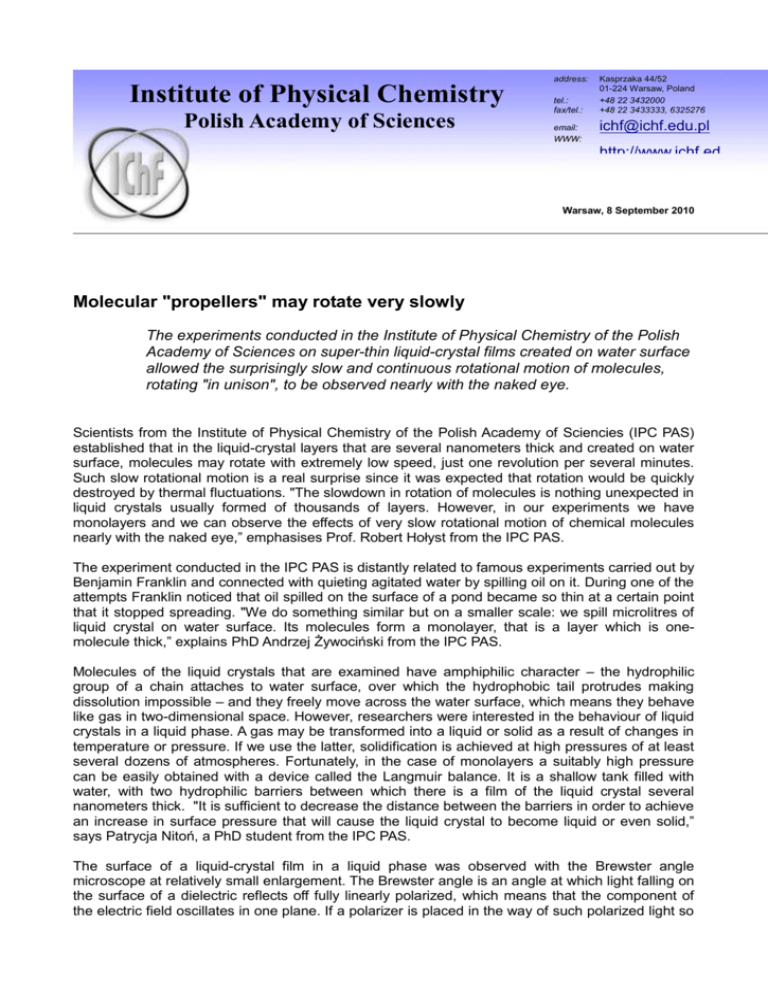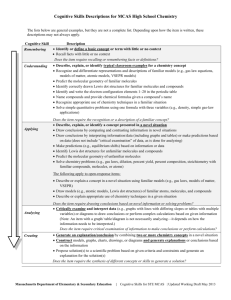The Institute of Physical Chemistry of the Polish Academy of Sciencies
advertisement

address: Institute of Physical Chemistry Polish Academy of Sciences tel.: fax/tel.: email: WWW: Kasprzaka 44/52 01-224 Warsaw, Poland +48 22 3432000 +48 22 3433333, 6325276 ichf@ichf.edu.pl http://www.ichf.ed u.pl/ Warsaw, 8 September 2010 Molecular "propellers" may rotate very slowly The experiments conducted in the Institute of Physical Chemistry of the Polish Academy of Sciences on super-thin liquid-crystal films created on water surface allowed the surprisingly slow and continuous rotational motion of molecules, rotating "in unison", to be observed nearly with the naked eye. Scientists from the Institute of Physical Chemistry of the Polish Academy of Sciencies (IPC PAS) established that in the liquid-crystal layers that are several nanometers thick and created on water surface, molecules may rotate with extremely low speed, just one revolution per several minutes. Such slow rotational motion is a real surprise since it was expected that rotation would be quickly destroyed by thermal fluctuations. "The slowdown in rotation of molecules is nothing unexpected in liquid crystals usually formed of thousands of layers. However, in our experiments we have monolayers and we can observe the effects of very slow rotational motion of chemical molecules nearly with the naked eye,” emphasises Prof. Robert Hołyst from the IPC PAS. The experiment conducted in the IPC PAS is distantly related to famous experiments carried out by Benjamin Franklin and connected with quieting agitated water by spilling oil on it. During one of the attempts Franklin noticed that oil spilled on the surface of a pond became so thin at a certain point that it stopped spreading. "We do something similar but on a smaller scale: we spill microlitres of liquid crystal on water surface. Its molecules form a monolayer, that is a layer which is onemolecule thick,” explains PhD Andrzej Żywociński from the IPC PAS. Molecules of the liquid crystals that are examined have amphiphilic character – the hydrophilic group of a chain attaches to water surface, over which the hydrophobic tail protrudes making dissolution impossible – and they freely move across the water surface, which means they behave like gas in two-dimensional space. However, researchers were interested in the behaviour of liquid crystals in a liquid phase. A gas may be transformed into a liquid or solid as a result of changes in temperature or pressure. If we use the latter, solidification is achieved at high pressures of at least several dozens of atmospheres. Fortunately, in the case of monolayers a suitably high pressure can be easily obtained with a device called the Langmuir balance. It is a shallow tank filled with water, with two hydrophilic barriers between which there is a film of the liquid crystal several nanometers thick. "It is sufficient to decrease the distance between the barriers in order to achieve an increase in surface pressure that will cause the liquid crystal to become liquid or even solid,” says Patrycja Nitoń, a PhD student from the IPC PAS. The surface of a liquid-crystal film in a liquid phase was observed with the Brewster angle microscope at relatively small enlargement. The Brewster angle is an angle at which light falling on the surface of a dielectric reflects off fully linearly polarized, which means that the component of the electric field oscillates in one plane. If a polarizer is placed in the way of such polarized light so that the light goes through it, it will stop the entire reflected light and under the Brewster angle microscope clean water will look black. However, if on the water surface there is something which twists the plane of polarization, bright reflections will appear. In the experiments conducted in the Institute of Physical Chemistry of the PAS it was analysed how a monolayer of a ferroelectric SmC* liquid crystal behaved on water surface. It is typical for SmC* phase that molecules spontaneously arrange themselves into layers and each subsequent layer is slightly twisted in relation to the others. "We have only one layer which we can imagine to be a forest of molecules inclined in the same direction at certain angle," explains PhD Żywociński. When water molecules evaporate, they hit into groups of atoms of various sizes which are connected with an asymmetric (chiral) carbon atom in each molecule of the liquid crystal. Due to the asymmetry, the fragments of molecules of liquid crystals protruding over the water surface act as the sails of a windmill and they start to rotate collectively (this effect was for the first time observed by Prof. Hiroshi Yokoyama from Japan). A molecule must be constructed in an appropriate way to be able to rotate. The polar group that keeps it at the water surface should not be too big as it would be immersed too deeply and would hinder the rotation caused by the asymmetric chiral group which is hit by the molecules of evaporating water. The chiral group, on the other hand, must remain distinctly above the surface. Rotating molecules change the polarization plane of the reflected light and in the field of view of the Brewster angle microscope there are areas of periodically changing brightness. The quickest rotation of molecules observed in this way lasted five seconds and the slowest as long as eight minutes. It is probably possible to achieve even slower rotational motion but not through the decrease of temperature (as liquid crystals become solid then) but by saturating the air with water vapour, which would decrease the pace of evaporation and thus the frequency of collision of water molecules and "sails" of liquid crystals. Slowly rotating molecules of liquid crystals can be used to construct nanodevices. "It is possible to construct a molecule in which a group of atoms playing the role of a sail would be a kind of a nanodrive. Then we would create a real molecular nanoengine driven by a water vapour stream," says PhD Żywociński, and he adds that scientists are now working on the possibility to transfer this collective rotation of single molecules to larger objects. The Institute of Physical Chemistry of the Polish Academy of Sciences (http://www.ichf.edu.pl/) was established in 1955 as one of the first chemical institutes of the PAS. The Institute's scientific profile is strongly related to the newest global trends in the development of physical chemistry and chemical physics. Scientific research is conducted in nine scientific departments. CHEMIPAN R&D Laboratories operating as part of the Institute implement, produce and commercialise specialist chemical compounds to be used, in particular, in agriculture and pharmacy. The Institute publishes approximately 300 original research papers annually. CONTACTS TO THE RESEARCHES: Prof. Robert Hołyst Institute of Physical Chemistry of the Polish Academy of Sciences tel. +48 22 3433123 email: holyst@ichf.edu.pl Ph.D. Andrzej Żywociński Institute of Physical Chemistry of the Polish Academy of Sciences tel. +48 22 3433247 email: zywot@ichf.edu.pl RELATED LINKS: http://www.ichf.edu.pl/ Website of the Institute of Physical Chemistry of the Polish Academy of Sciences (PAS). http://www.ichf.edu.pl/press/ Press releases on the Institute of Physical Chemistry of the PAS. IMAGES: IChF100908b_fot01s.jpg HR: http://ichf.edu.pl/press/2010/09/IChF100908b_fot01.jpg PhD Andrzej Żywociński and a PhD student Patrycja Nitoń near the Langmuir tank with the use of which they examine liquid-crystal monolayers on the water surface. (Source: IPC PAS, Grzegorz Krzyżewski) IChF100908b_fot02s.jpg HR: http://ichf.edu.pl/press/2010/09/IChF100908b_fot02.jpg The effects of rotation of liquid-crystal molecules in a monolayer. The marked area changes periodically from dark into bright, depending on how the rotating molecules twist the polarization plane of the reflected light. False colours. (Source: IPC PAS) MOVIES: IChF100908c_mov01.avi HR: http://ichf.edu.pl/press/2010/09/IChF100908c_mov01.avi 640x480, 3.58 MB The film made at the Institute of Physical Chemistry of the PAS shows water surface covered with a liquid crystal monolayer. Rotating molecules change the polarization plane of the reflected light and cause periodic changes in brightness, which are particularly well noticeable in the spiral at the bottom of the monitor. The field of view is 4.8 x 6.4 mm. (Source: IPC PAS)









